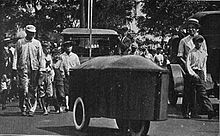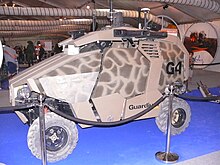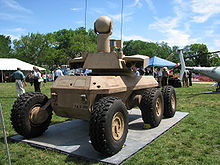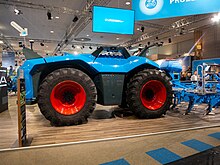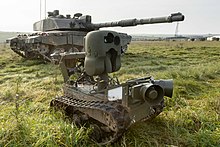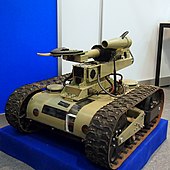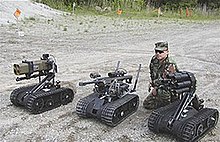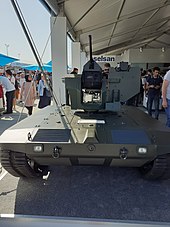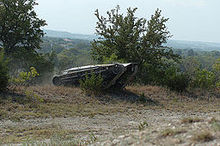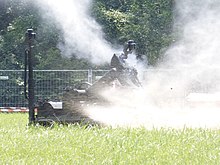
The Defense Advanced Research Projects Agency (DARPA) is a research and development agency of the United States Department of Defense responsible for the development of emerging technologies for use by the military.
An autonomous robot is a robot that acts without recourse to human control. Historic examples include space probes. Modern examples include self-driving vacuums and cars.
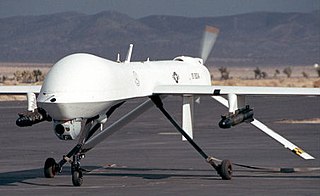
Military robots are autonomous robots or remote-controlled mobile robots designed for military applications, from transport to search & rescue and attack.
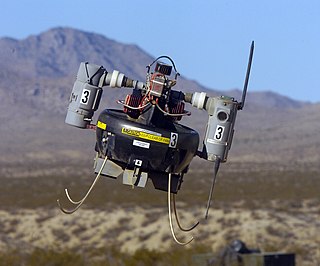
A micro air vehicle (MAV), or micro aerial vehicle, is a class of man-portable miniature UAVs whose size enables them to be used in low-altitude, close-in support operations. Modern MAVs can be as small as 5 centimeters - compare Nano Air Vehicle. Development is driven by commercial, research, government, and military organizations; with insect-sized aircraft reportedly expected in the future. The small craft allow remote observation of hazardous environments or of areas inaccessible to ground vehicles. Hobbyists have designed MAVs for applications such as aerial robotics contests and aerial photography. MAVs can offer autonomous modes of flight.

The Multi-Mission Unmanned Ground Vehicle, previously known as the Multifunction Utility/Logistics and Equipment vehicle (MULE), was an autonomous unmanned ground combat vehicle developed by Lockheed Martin Missiles and Fire Control for the United States Army's Future Combat Systems and BCT Modernization programs. The last component of the program was canceled in July 2011.
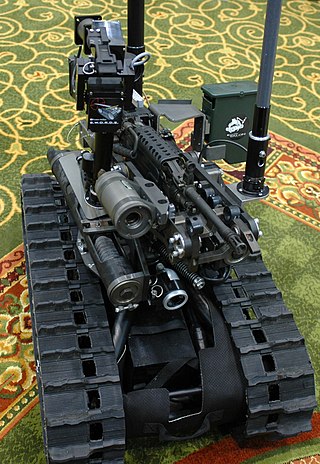
The Foster-Miller TALON is a remotely operated vehicle, and it is a small, tracked military robot designed for missions ranging from reconnaissance to combat. It is made by the American robotics company QinetiQ-NA, a subsidiary of QinetiQ.

A mobile robot is an automatic machine that is capable of locomotion. Mobile robotics is usually considered to be a subfield of robotics and information engineering.
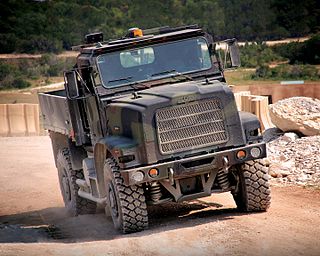
TerraMax is the trademark for autonomous/unmanned ground vehicle technology developed by Oshkosh Defense. Primary military uses for the technology are seen as reconnaissance missions and freight transport in high-risk areas so freeing soldiers from possible attacks, ambushes or the threat of mines and IEDs. The technology could also be used in civilian settings, such as autonomous snow clearing at airports.
The Black Knight is a prototype unmanned ground combat vehicle (UGCV) designed by BAE Systems. It weighs approximately 12 tons and is deployable from a Lockheed C-130 Hercules; ie airlifted by military transport aircraft. Similar in appearance to a tank, it is armed with a turret-mounted 25 mm gun and a 7.62 mm coaxial machine gun. The vehicle is fitted with a 300-horsepower (220 kW) Caterpillar Inc. diesel engine. The vehicle is currently being evaluated by the US Army. It is a proof of concept for military unmanned vehicles, specifically as a combat asset.
Squad Mission Support System is an unmanned all terrain wheeled vehicle developed by Lockheed Martin.

An uncrewed vehicle or unmanned vehicle is a vehicle without a person on board. Uncrewed vehicles can either be under telerobotic control—remote controlled or remote guided vehicles—or they can be autonomously controlled—autonomous vehicles—which are capable of sensing their environment and navigating on their own.

Guardium, developed by G-NIUS, is an Israeli unmanned ground vehicle (UGV) used by the Israel Defense Forces along Gaza's border. It was jointly developed by Israel Aerospace Industries and Elbit Industries. It can be used in either tele-operated or autonomous mode. Both modes do not require human interaction. The more unmanned ground vehicles patrolling the area the less human resources needed while guaranteeing deterrence. The joint program was terminated in April 2016, but the vehicle has remained in service with the IDF.

The Ripsaw is a series of developmental unmanned ground combat vehicles designed by Howe & Howe Technologies for evaluation by the United States Army.

The ASW Continuous Trail Unmanned Vessel (ACTUV) is a DARPA funded project launched in early 2010 to develop an anti-submarine drone. ASW is an acronym for Anti-Submarine Warfare. In January 2018 after successful sea trials it was announced that the "Sea Hunter" prototype has transitioned from DARPA to the Office of Naval Research for further development.
The Modular Advanced Armed Robotic System (MAARS) is a robot that is being developed by Qinetiq. A member of the TALON family, it will be the successor to the armed SWORDS robot. It has a different, larger chassis than the SWORDS robot, so has little physically in common with the SWORDS and TALON
The Learning Applied to Ground Vehicles (LAGR) program, which ran from 2004 until 2008, had the goal of accelerating progress in autonomous, perception-based, off-road navigation in robotic unmanned ground vehicles (UGVs). LAGR was funded by DARPA, a research agency of the United States Department of Defense.
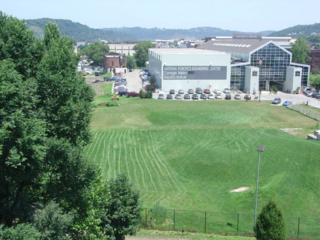
The National Robotics Engineering Center (NREC) is an operating unit within the Robotics Institute (RI) of Carnegie Mellon University. NREC works closely with government and industry clients to apply robotic technologies to real-world processes and products, including unmanned vehicle and platform design, autonomy, sensing and image processing, machine learning, manipulation, and human–robot interaction.

Counter-IED equipment are created primarily for military and law enforcement. They are used for standoff detection of explosives and explosive precursor components and defeating the Improvised Explosive Devices (IEDs) devices themselves as part of a broader counter-terrorism, counter-insurgency, or law enforcement effort.
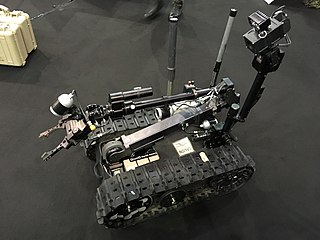
UGV Interoperability Profile (UGV IOP), Robotics and Autonomous Systems – Ground IOP (RAS-G IOP) or simply IOP was originally an initiative started by the United States Department of Defense (DoD) to organize and maintain open architecture interoperability standards for Unmanned Ground Vehicles (UGV). A primary goal of this initiative is to leverage existing and emerging standards within the Unmanned Vehicle (UxV) community such as the Society of Automotive Engineers (SAE) AS-4 Joint Architecture for Unmanned Systems (JAUS) standard and the Army Unmanned Aircraft Systems (UAS) Project Office IOPs.
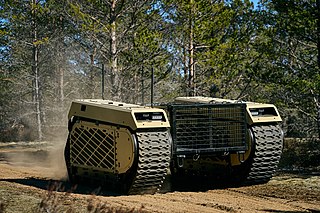
THeMIS, unmanned ground vehicle (UGV), is a ground-based armed drone vehicle designed largely for military applications, and is built by Milrem Robotics in Estonia. The vehicle is intended to provide support for dismounted troops by serving as a transport platform, remote weapon station, IED detection and disposal unit etc.


